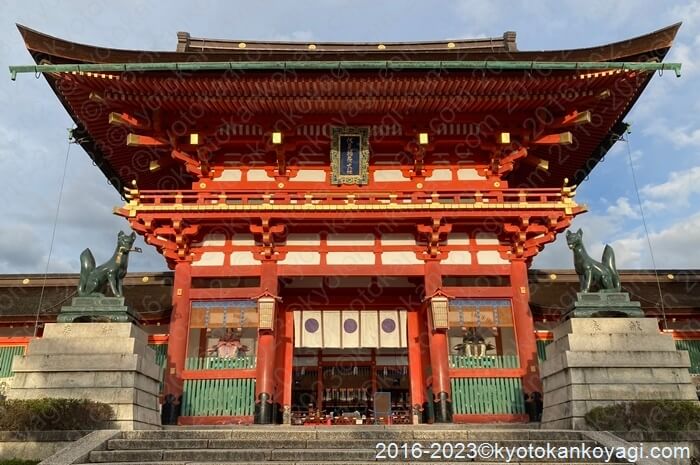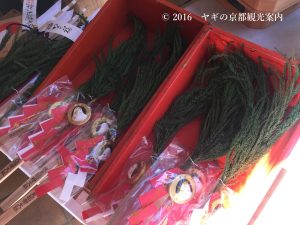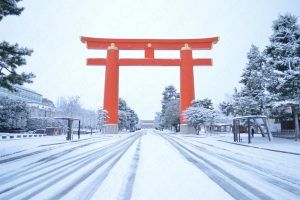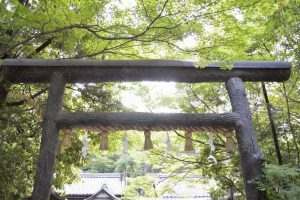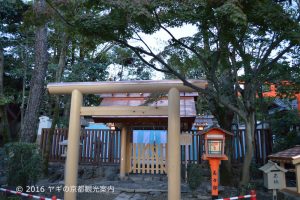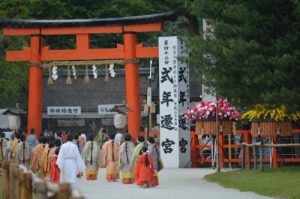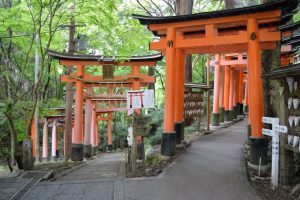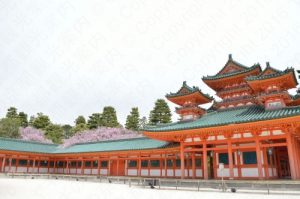THE GIST OF THIS ARTICLE
-
- Page 1 Introduction, History, Torii
- Page 2 Foxes, Hike part 1
- Page 3 Hike part 2
- Page 4 Hike part 3
- Page 5 Access
The following is the contents of this article.
Introduction
In this post, you can learn about Fushimi Inari Taisha ; Its history, Senbon Torii gates, foxes, and Oyama meguri-tour.合掌
The short history of Fushimi Inari Taisha 伏見稲荷大社の歴史
The early history of Fusimi Inari Taisha remains to be secret but Yamashiro no Kuni Fudoki, or The Report of Ancient Kyoto Province, the most reliable source compiled under the order from the emperor in the 6th century, tells the shrine was founded in 711 D.C.
The following is my translation :” Hata no Irogu of the Hata clan was very prosperous thanks to rice farming. One day, he shot an rice cake with an arrow. On the spot, the cake became a white bird and flew away to a mountain. Simultaneously, the mountain had a huge rice harvest. He was so impressed that he enshrined 3 Deities on 3 peaks in the mountain. That is the reason why we call it (the ancient Fushimi Inari Taisha.) “Inari”. (The word “Inari” means “Rice harvest” in Japanese.) The descendants of Irogu ashamed the deeds of their ancestor and pull a small tree out of the ground of the shirne and brought it back their home. ”
At the beginning, Fushimi Inari Taisha was a shrine respected by the Hata clan. I suppose these 3 Deities are “Inari no Ohkami”.
In the 8th century, under the fusion of the Shinto and the Buddhism, Kukai, the founder of the Shingon school, enshrined Inari no Ohkami as a Deity who saves Toji temple. The emperors often visited the shrine and Fusimi Inari Shrine became one of the most popular shrine as Yasaka shrine of that time (Today, Yasaka shrine is a Shinto shrine but was a Buddhist temple).
In the 15th century, Onin no ran, the largest civil war in the Japanese Medieval ages, occurred. It lasted for 10 years and Fushimi Inari Taisya was burnt out completely.
After the war was ended, Fushimi Inari Taisya was managed to gain donations, and retrieved its fortune. In the 16th century, Toyotomi Hideyoshi donated the Romon gate we can still see there today.
In the Edo period, Inari no Ohkami became very popular among merchants and they started to donate Torii gates. They are the origin of Senbon Torii today.
Today, we regard Ukano mitana no Ohkami as the same Deity as Inari no Ohkami.
In the main hall of Fushimi Inari Taisha, Ukano mitama no Ohkami is enshrined.

Torii gates in Fusimi Inari Taisha 伏見稲荷大社の鳥居
The origin of Torii gate
Fushimi Inari Taisha is famous for Torii gates. So, let us learn about Torii gates first.
Torii is a gate which devides a sacred and a secular world. Usually, Shinto shrines has a torii at an entrance. We can not tell its origin exactly. Some source says it was built in front of shrine to let “Tokoyo no Naganaki-dori” stay on.
Tokoyo no Naganaki-dori is a rooster. In Japanese mythology, “Amaterasu Ohmikami”, the highest ranked Deity in the Shinto, hid behind the huge door of rock because of the rough behavior of her brother. After the incident, the world fell into the night. The other Deities tried to lure her outside of the door. As one of the attempts they made, they let roosters crowed.( She finally got out of the door and the new day dawned.) Because of this story, Ise shrine, the shrine Amaterasu Ohmikami was enshrined, keeps roosters as envoy of her.
Take a look at the picture above. This is the most primitive fashion of torii. Torii gate is made with barked tree usually but this torii wood is not barked. This torii is developed into two kinds of torii.
One is “Shinmei toii”.
The other is “Myohjin torii”. The toriis in Fushimi Inari Taisha belong to this kind. The difference between them is not color but the upper part of the torii. The upper part of Shinmei torii is flat and that of Myojin torii is curved.
As we discussed in the last chapter, Fushimi Inari Taisha became popular among merchants in Edo period. They asked Inari no Ohkami to let them prosperous with her power. When thier wishes became true, they donated Toriis to the shrine. It is said that there are about 10,000 Toriis and we can donate them even today.
Torii is painted in color called “Niiro”. Niiro is believd to be color prevent us from anything evil. The paint is made from cinnabar and keeps away wood from rot. Take a look at the picture above. That is a building of Heian Jingu shrine. It is a replica of a building of the ancient Imperial court. It is painted in the same color.
The beginning of “Senbon Torii”
As we discussed before, Torii is a gate which means the entrance of a sacred world but Senbob Torii has defferent meaning.
In Edo period (1603-1686), a merchant in Edo went into decline. He visited Inari shrine many times and he became very prosperous.
After the incident, many merchants visit Inari shrine and dedicated Totii gates as a gratitude for their prosperity.
We can devide the word “Torii” into 2 words: “To-ru” and “i “. It is a kind of rendition of Japanese words we always take. We translate the word as “Wish comes true”. This is the reason why we consider Torii as a thing has to do with prosperity.


